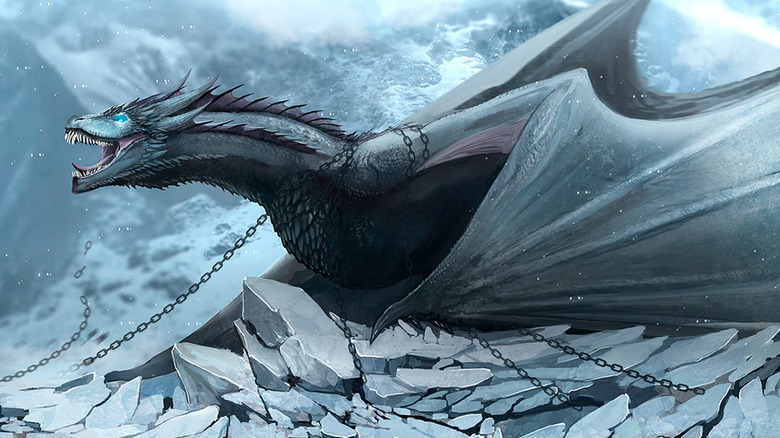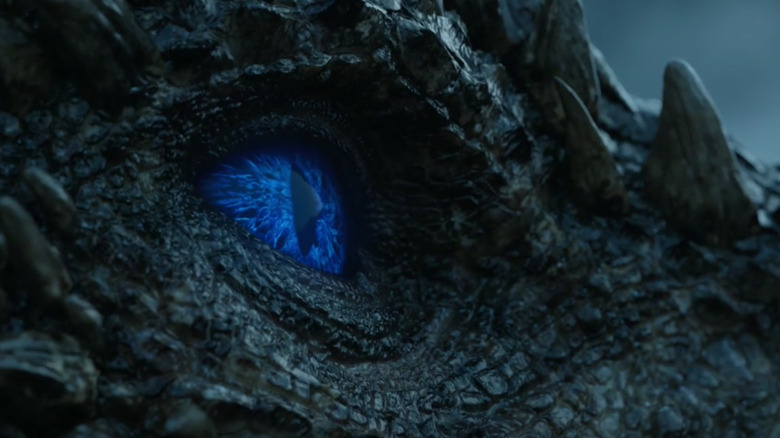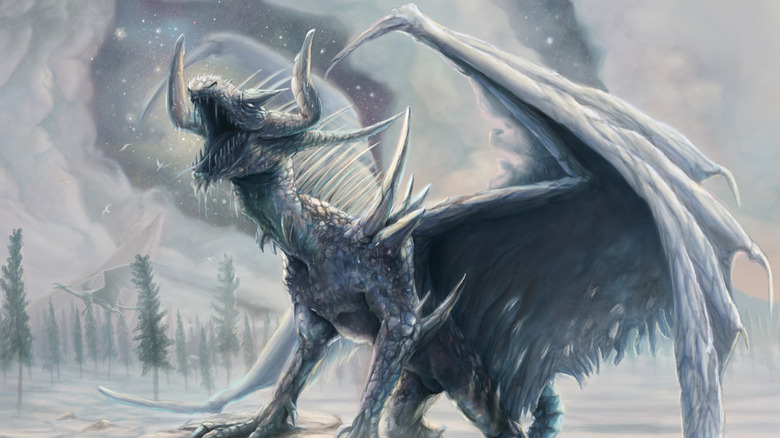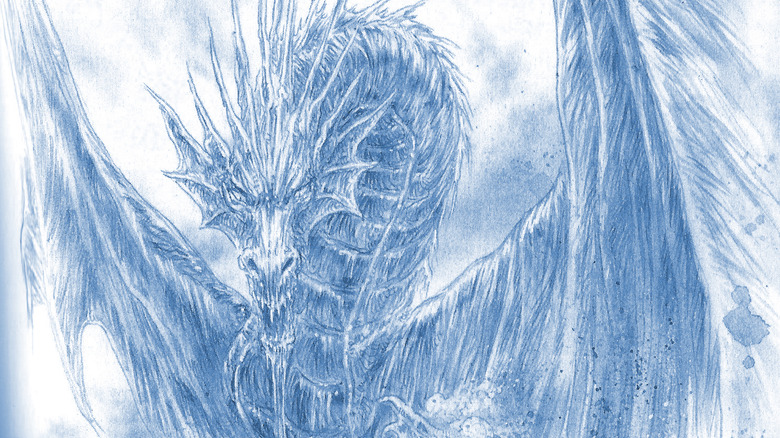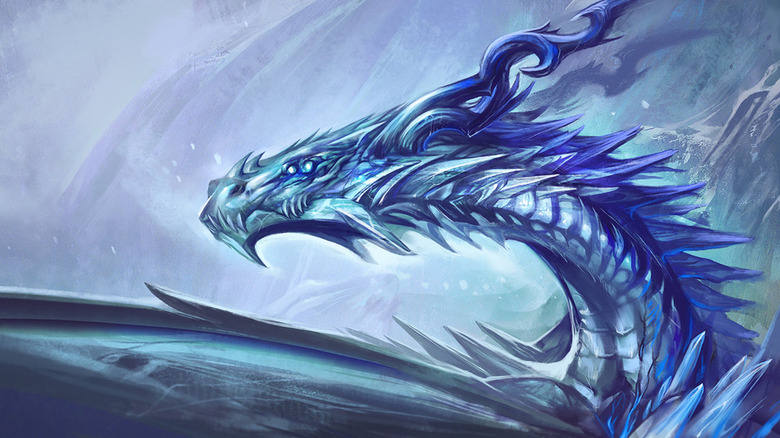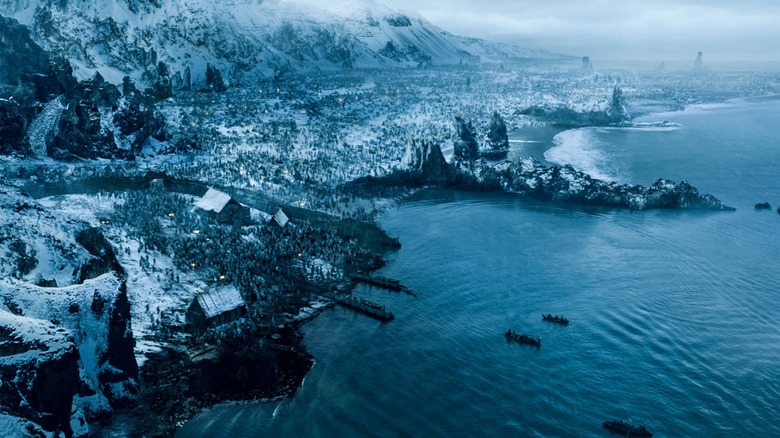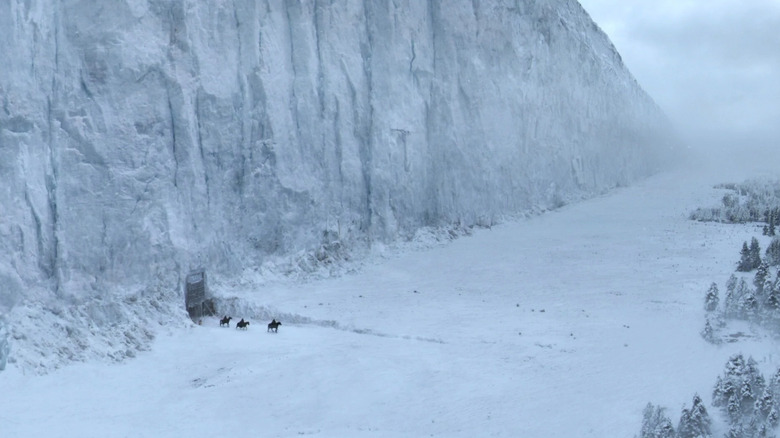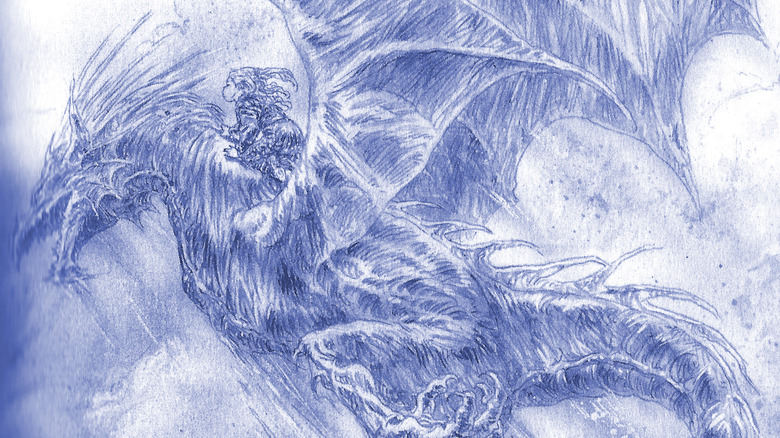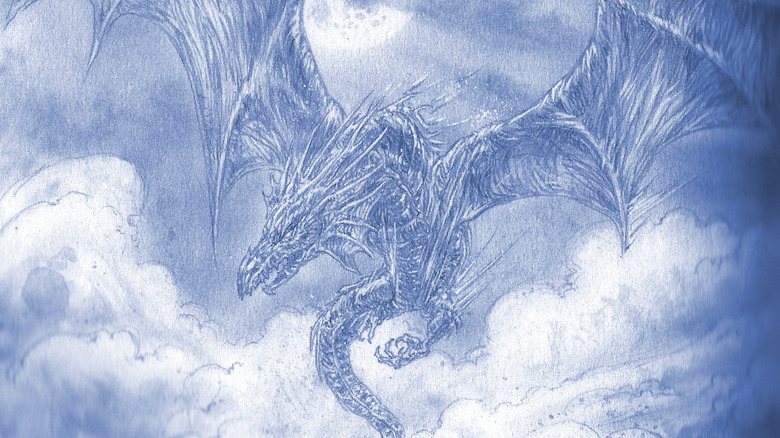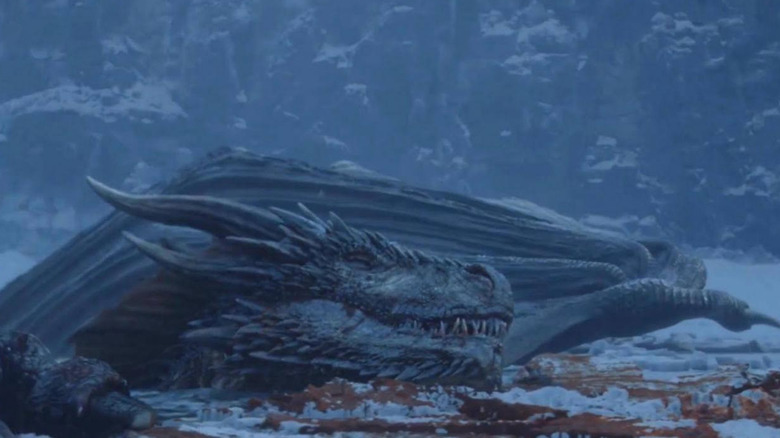Everything We Know About Ice Dragons In Game Of Thrones
After the events of season seven, episode six on Game of Thrones, speculation has run rampant regarding the dragon Viserion and his possible new capabilities now that he's been killed and raised from the dead by the Night King. Much of the speculation has centered on the legend of the Ice Dragon, using evidence from the George R.R. Martin novella The Ice Dragon to back up the claims. Let's take a look at what we know about Ice Dragons, and how that might (or might not) apply to Viserion's future as the Night King's mount.
They've been around much longer than you think
Although there's been a surge of interest surrounding Ice Dragon lore following the penultimate episode of season seven on Game of Thrones, George R.R. Martin first wrote of them in 1980 in his children's book The Ice Dragon. Much of what we know about Ice Dragons comes from that novella, although they've been mentioned on occasion in his A Song of Ice and Fire works—the first book of which, A Game of Thrones, was published 16 years after The Ice Dragon.
It's important to note that the information gleaned from The Ice Dragon might not be considered canon in Game of Thrones; in a 2015 comment on his blog, Martin told a reader that the novella wasn't part of the world of Ice & Fire, because "the world of Ice & Fire did not exist when I wrote The Ice Dragon." To add to the confusion, there's similar lore in both works, and The Ice Dragon's publisher claimed it was part of Westeros on the book jacket.
They're made of actual ice
In The Ice Dragon, readers are told that the creature is literally made of ice: "The ice dragon was a crystalline white, that shade of white that is so hard and cold that it is almost blue. It was covered with hoarfrost, so when it moved its skin broke and crackled as the crust on the snow crackles beneath a man's boots, and flakes of rime fell off." Like other dragons, an ice dragon has wide batlike wings, but the wings of an ice dragon are a "faint translucent blue." Its mouth is deep blue inside, lined with a triple row of actual icicles for teeth.
Additionally, they're known to be quite large. While the fire-breathing dragons seen in The Ice Dragon were around five times the size of a horse, an Ice Dragon was "half again the size of the scaled green war dragons." If a "normal" dragon was around 25 feet tall at the shoulder, that would mean an Ice Dragon stands a massive 37.5 feet tall.
They bring and prolong winters
Although Ice Dragons were considered rare, they were sighted occasionally by the peoples in The Ice Dragon, who knew their appearance heralded a long and bitter winter: "When the ice dragon beat its wings, the cold winds blew and the snow swirled and scurried and the world seemed to shrink and shiver."
After Adara befriends the dragon and begins to ride it, every winter it stays longer in the land, and every winter lasts longer than the last—to the point that the people begin to wonder if there will even be time for a planting season once spring finally arrives.
They breathe cold, not fire
Unlike their flesh and blood counterparts, Ice Dragons doon't breathe a roaring fire, but a silent stream of cold. "Ice formed when it breathed. Warmth fled. Fires guttered and went out, shriven by the chill. Trees froze through to their slow secret souls, and their limbs turned brittle and cracked from their own weight. Animals turned blue and whimpered and died, their eyes bulging and their skin covered over with frost. The ice dragon breathed death into the world; death and quiet and cold."
Later in The Ice Dragon, we get to see the creature in action with his frosty breath, and he's able to take out three enemy fire-breathing dragons and their riders. His icy attack is so effective that the enemies are dead and frozen solid before they even hit the ground.
They live far to the north
In The Ice Dragon, we learn from Adara that the creature lives far to the north of her land. In one chapter, she thinks twice about "the land of always-winter," where she believes the Ice Dragon lives. There, "great ice castles and cathedrals of snow stood eternally in endless fields of white, and the stillness and silence were all." The "Land of Always Winter" also makes an appearance in the Ice and Fire novels. It's located far to the north in Westeros, as far north as one can go, beyond the Frostfang mountains. It's believed the area has always been locked in perpetual winter, and is largely unexplored. Some legends claim that the White Walkers first emerged from this area ages ago during the Long Night. Interestingly, one constellation in the night sky of Westeros is called "The Ice Dragon," the blue "eye" of which acts like our North Star—lost adventurers can use it to always find north.
Another area mentioned in connection with Ice Dragons in the novels about Westeros is the Shivering Sea, a vast, cold ocean which lies to the east of Westeros and north of the entire continent of Essos. We've seen it a couple of times onscreen—both at Hardhome (pictured above) and when Jon's boat came to Eastwatch. To the north of the Shivering Sea is the White Waste, an area of perpetual ice and frozen tundra, with shorelines that change depending on the season. Sailor's legends surrounding the Shivering Sea claim Ice Dragons live there, and that they're much larger than Valyrian dragons, made entirely of ice and with translucent wings—a description very similar to that found in The Ice Dragon.
There might be one inside the Wall
According to one popular fan theory, there may be an Ice Dragon trapped within the Wall itself. On several occasions, Jon Snow thinks about Ice Dragons while at the Wall, even comparing walking through the tunnel below it at Castle Black to be like "walking down the gullet of an ice dragon."
It's believed that at one point, the Children of the Forest and the First Men could be found all throughout Westeros—even near (or possibly in) the Land of Always Winter itself. We've learned from the show that the Children created the White Walkers to defend them against the First Men, but their creation got out of control and became a threat to all living things. Eventually the Children and the First Men made a Pact, and they became allies throughout the Age of Heroes and the Long Night—when the White Walkers emerged from the Land of Always Winter and drove the Children and First Men south. According to legends, the first members of the Night's Watch drove off the White Walkers, and Bran the Builder raised the Wall not long after, with (it's said) the aid of giants, the Children, and magic.
It's interesting to note that the frozen mountain which featured prominently in season seven, episode six has appeared before—in the season six scene when Leaf creates the first White Walker. At that time, the area was temperate, with grass and trees growing everywhere. Did the White Walkers cause the area north of the Wall to become perpetually cold, or could it be the effects of an Ice Dragon? Could the legendary magic and spells used in the building of the Wall be partly due to the presence of a dragon—said to be able to increase the potency of magic by their very existence?
They can't be trained
According to The Ice Dragon, these mythical creatures can't be trained or ridden—at least not by most humans. "We have tales of those that tried, found frozen with their whip and harness in hand," reads Martin's text. "I've heard about people that have lost hands or fingers just by touching one of them. Frostbite."
While that proves to not be a problem for Adara, who's frequently described as "a cold child," that means most normal humans would never be able to attempt to train or ride one, at least not if they value their life. That being said, the Night King and his White Walkers aren't normal humans, and they likely wouldn't be affected by the icy breath or nature of an Ice Dragon.
They are easily melted
Being completely made of ice, an Ice Dragon is naturally extremely susceptible to warmth of any kind. When the creature comes to save Adara during the last of summer, she notices immediately how shrunken it seems because of the warm climate. Later, her hot tears falling on its back make noticeable holes. Finally, while it was able to take out the three enemy dragons, their fire breath did massive damage; one flame attack left a gaping and dripping wound on its belly, and another managed to burn one of its fragile translucent wings completely away. Adara returns later to find her Ice Dragon has melted away forever—leaving behind only "a small quiet pool where the water was very cold."
Viserion isn't one
With essentially all there is to know about Ice Dragons out of the way, it's well worth noting that Viserion isn't one of them. He's an undead dragon. He was a dragon made of flesh and blood that breathed fire, and he isn't made of ice now that he's been raised from the dead. Like the other undead raised by the White Walkers (people, horses, and that terrifying bear), he doesn't gain any new powers —except that he can now only be killed by fire, Valyrian steel, or dragonglass.
While it would undoubtedly be handy for the Night King to have some Ice Dragons on his side to freeze his enemies, they continue to remain hidden—for now. It's questionable whether Viserion can even still breathe fire at all, since the Night King's spear seemed to puncture his throat. That being said, if he is able, he'll still be breathing fire—and he won't melt if he's exposed to warmer weather, which will no doubt come in handy if the Night King decides to take his new mount to attack the Wall. At that point, all bets are off.
